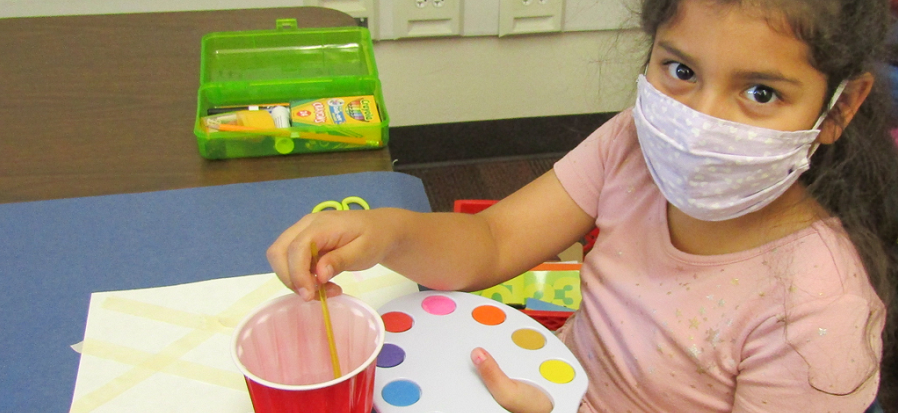Tasked with planning and implementing remote learning for over 55 million children in the U.S. in the wake of COVID-19 school closures, districts and teachers relied heavily on families* to support youth learning. Many families took on intense new levels of responsibility in education, while other pressures on families increased simultaneously. The U.S. Census Bureau reported that 16% of families experienced new food insecurity and 17% of families with school-age children became unemployed during the pandemic.1 The Family-School Collaboration Design Research Project noted, “this pandemic—along with the many overlapping pandemics our nation now faces, including racial, economic, political, and environmental injustices—has also heightened existing barriers between families and schools.”(2)
In 2017, through a collaborative process with families, policymakers, community members, and teachers, a coalition in Connecticut defined family engagement as “a full, equal, and equitable partnership among families, educators, and community partners to promote children’s learning and development from birth through college and career.”(3) Families taking on new roles in learning during the pandemic stretched the idea of school-family partnerships to new levels. Overnight schools and teachers made family engagement a top priority and sought unique, flexible, sustainable, and effective strategies to reach all families and build school family partnerships. The new focus on remote opportunities also pushed schools beyond traditional, in-person, and event-based engagement, opening up variation in how school-family partnerships can be successful.(4)
While prioritizing family engagement at this level may be new, there is long-established research on the benefits of family support in student learning and improving schools.(5) The National Center for Family & Community Connections with Schools reviewed several studies and found positive associations between family involvement and students’ growth, including increased academic achievement. Westat and Policy Studies Associates found that underperforming elementary and middle schoolers’ scores grew 40 percent higher when teachers frequently met with or called families and sent materials home to families with information about how to support learning.
In the out-of-school time (OST) space, a RAND study found that family involvement is an important quality indicator of effective summer learning.(6) Additionally, a recent RAND study of BellXcel found summer programs have great potential to provide teachers with valuable professional learning and increased skills,(7) including strategies for building family connections. With the national shift to prioritize family engagement, the clear benefits for families, staff, and students, and the opportunity of summer learning as a way to bridge gaps, family engagement in summer programs is more critical than ever.
BellXcel Remote Model and Family Engagement Elements
He is a lot calmer now. I know [his teachers] gave me daily reports [on] what I can do to help him calm down and be more attentive. These individuals will hold a special place in my son’s heart, and he cried when I told him this was his last week.
Survey response from a family participating in a remote summer learning program
To serve youth (called “scholars”) in 2020, BellXcel, a national non-profit that empowers partners to deliver evidence-based OST learning programs, quickly developed an innovative remote summer learning model called BellXcel Remote. Aware of the increased role of families in education, and a desire to reach families and scholars regardless of scheduling or technology constraints, BellXcel designed key elements for the Remote model. These elements included an online family resource portal, a comprehensive family guide, and professional development to staff to encourage more robust and consistent communication with families. The Sperling Center for Research and Innovation (SCRI) released a research brief called Building Bridges During Challenging Times: How BellXcel Remote Summer Programs Kept Youth, Families and Staff Engaged in Learning During COVID-19, which found that BellXcel’s remote partners’ programs bridged a gap between a disrupted 2019-20 school year and the 2020-21 school year, noting the efficacy of increased focus on flexible family engagement strategies.
To further understand family engagement in BellXcel’s partner programs, SCRI reviewed qualitative and quantitative data on participants’ experiences using end of-program staff and family surveys, and the quality self-reflection tool. SCRI discovered that remote summer programs using the BellXcel model established supportive and consistent relationships between staff and families which empowered families to support their children’s learning. Staff integrated high quality family engagement strategies throughout the program which included frequent communication and meaningful outreach to support participants.
Download Full Research Brief
Definitions and Sources
*”Family” is used throughout this brief to describe the person or people who are the primary points of contact, or primarily responsible for a child’s learning in the home (i.e., parent, grandparent, guardian, or caregiver).
- Harwin, A. & Furuya, Y. (2021, January 19). Where families are feeling pandemic impacts the worst. EdWeek. Link: https://www.edweek.org/leadership/where-families-are-feeling-pandemic-impacts-the-worst/2021/01
- Alvarez Gutierrez, L., Hernandez, L., Kim, T., Kuttner, P.J., Lopez, G.R., Mayer-Glenn, J., Niang, A. & Yanagui, A. (2020, October 6). Family-school relationships are the missing link in COVID-19 era education. EdWeek. Link: https://www.edweek.org/leadership/opinion-family-school-relationships-are-the-missing-link-in-covid-19-era-education/2020/10
- Connecticut State Department of Education. (n.d.). Full, equal and equitable partnerships with families. Link: https://portal.ct.gov/SDE/Publications/Full-Equal-and-Equitable-Partnerships-with-Families/The-Definition-A-Clear-Consensus. Definition referenced in a live webinar: Mapp, K., Lancaster, D., Stock, E. (2021, March 16). Now more than ever: family engagement for student success with Dr. Karen Mapp [Webinar]. EdWeek. Link: https://www.edweek.org/events/webinar/familyengagement-for-student-success-with-dr-karen-mapp
- Alvarez Gutierrez, L., Hernandez, L., Kim, T., Kuttner, P.J., Lopez, G.R., Mayer-Glenn, J., Niang, A. & Yanagui, A. (2020, October 6). Family-school relationships are the missing link in COVID-19 era education. EdWeek. Link: https://www.edweek.org/leadership/opinion-family-school-relationships-are-the-missing-link-in-covid-19-era-education/2020/10
- Henderson, A. T., & Mapp, K. L. (2002). A new wave of evidence. The impact of school, family, and community connections on student achievement. Austin [Texas]: National Center for Family & Community: Connections with Schools. Link: https://sedl.org/connections/resources/evidence.pdf
- McCombs, J. S., Augustine, C. H., & Schwartz, H. L. (2011). Making summer count: How summer programs can boost children’s learning. Link: https://www.wallacefoundation.org/knowledgecenter/pages/making-summer-count-how-summer-programs-can-boost-childrens-learning.aspx
- Steiner, E.D., Stelitano, L., Bogart, A. & Meyers, S. (2021) The Promise of Summer as a Time for Teacher Professional Learning: Findings from a National Survey and Implications from the BellXcel Program. Santa Monica, CA: RAND Corporation. Link: https://www.rand.org/pubs/research_reports/RRA196-1.html.




